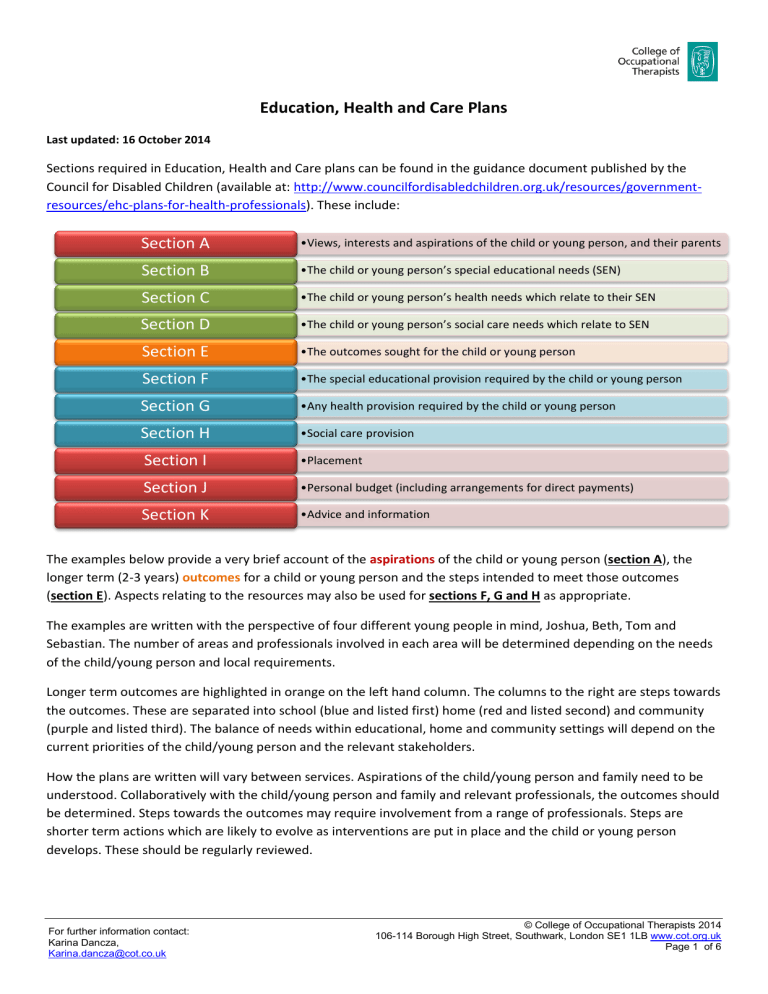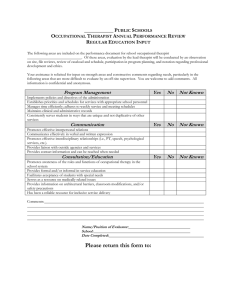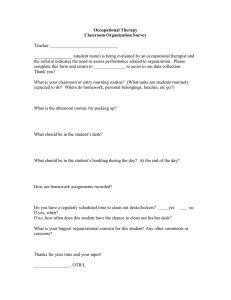
Education, Health and Care Plans Last updated: 16 October 2014 Sections required in Education, Health and Care plans can be found in the guidance document published by the Council for Disabled Children (available at: http://www.councilfordisabledchildren.org.uk/resources/governmentresources/ehc-plans-for-health-professionals). These include: Section A •Views, interests and aspirations of the child or young person, and their parents Section B •The child or young person’s special educational needs (SEN) Section C •The child or young person’s health needs which relate to their SEN Section D •The child or young person’s social care needs which relate to SEN Section E •The outcomes sought for the child or young person Section F •The special educational provision required by the child or young person Section G •Any health provision required by the child or young person Section H •Social care provision Section I •Placement Section J •Personal budget (including arrangements for direct payments) Section K •Advice and information The examples below provide a very brief account of the aspirations of the child or young person (section A), the longer term (2-3 years) outcomes for a child or young person and the steps intended to meet those outcomes (section E). Aspects relating to the resources may also be used for sections F, G and H as appropriate. The examples are written with the perspective of four different young people in mind, Joshua, Beth, Tom and Sebastian. The number of areas and professionals involved in each area will be determined depending on the needs of the child/young person and local requirements. Longer term outcomes are highlighted in orange on the left hand column. The columns to the right are steps towards the outcomes. These are separated into school (blue and listed first) home (red and listed second) and community (purple and listed third). The balance of needs within educational, home and community settings will depend on the current priorities of the child/young person and the relevant stakeholders. How the plans are written will vary between services. Aspirations of the child/young person and family need to be understood. Collaboratively with the child/young person and family and relevant professionals, the outcomes should be determined. Steps towards the outcomes may require involvement from a range of professionals. Steps are shorter term actions which are likely to evolve as interventions are put in place and the child or young person develops. These should be regularly reviewed. For further information contact: Karina Dancza, Karina.dancza@cot.co.uk © College of Occupational Therapists 2014 106-114 Borough High Street, Southwark, London SE1 1LB www.cot.org.uk Page 1 of 6 A: Joshua’s aspirations are to do more things on his own so that he can make friends and successfully achieve at primary and secondary school. E. Outcomes: what this means for the child/young person For Joshua to organise himself at school so that he needs minimal additional support from the school staff to participate in school activities. For Joshua to make friends and participate socially in activities at home and in the community. Steps towards outcomes Indicative actions: What will be done and who will do it? Resources (including frequency) Arriving at school: Joshua will find his peg and hang his coat and bag up, by October 2014. During the Autumn term 2014, the occupational therapist will visit the school three times and work in collaboration with the teacher to establish, monitor and review strategies. Also daily support from school staff. Participating in breakfast club: Joshua will get his choice of breakfast and find a place to sit at breakfast club, by November 2014. Riding a bike at home: Joshua will be able to get on his bike, pedal and stop, by April 2015. Attending Scouts: Joshua will be able to attend and participate in Scouts, by October 2014. For further information contact: Karina Dancza, Karina.dancza@cot.co.uk The class teacher will move Joshua’s coat peg to the end of the row, and work with all the children to develop ways of identifying individual coat pegs. The occupational therapist will work with Joshua and the learning support assistant to develop skills for taking off and putting on his coat. The occupational therapist will work with the breakfast club staff to arrange a consistent place for Joshua to sit each day. The occupational therapist will work with Joshua and his family to plan what breakfast Joshua will choose each day. Joshua will attend the occupational therapy bike riding group to develop his cycling skills. Joshua and his parents will practice cycling with the support of the occupational therapist. The occupational therapist will liaise with the Scout leader and negotiate strategies to assist Joshua to participate in the Scout activities. During the Autumn term 2014, the occupational therapist will visit the school three times and work in collaboration with the breakfast club staff to establish, monitor and review strategies. Also daily support from school staff and family. During the Autumn half term week Joshua will attend the bike riding group. Weekly support from the family and up to two visits from the occupational therapist. The occupational therapist will visit the Scout group and provide three additional telephone consultations to support the Scout leader to grade and adapt the activities. © College of Occupational Therapists 2014 106-114 Borough High Street, Southwark, London SE1 1LB www.cot.org.uk Page 2 of 6 A: Beth’s aspirations are to be able to care for herself and be able to manage her daily living needs in the community. E. Outcomes: what this means for the child/young person For Beth to participate in the usual classroom routines with moderate assistance from the school staff. For Beth to play with other children. Steps towards outcomes Indicative actions: What will be done and who will do it? Resources (including frequency) Lining up: Beth will follow the teacher’s instructions when lining up to go back into the classroom, by October 2014. The occupational therapist and speech and language therapist will work together with the class teacher to provide visual and verbal cues for Beth that she is able to follow. Going to the toilet: Beth will make the teacher aware of when she needs to go to the toilet, by October 2014. Playing with a friend: Beth will play with a friend/sibling at home, by February 2015. The occupational therapist in collaboration with the speech and language therapist will work with Beth and the classroom teacher to enable Beth to recognise when she needs to use the toilet and attract the teacher’s attention. The occupational therapist will work with the Beth’s parents to establish suitable activities which encourage cooperative play and could be used in the garden. The occupational therapists in collaboration with the speech and language therapist will work together with Beth and her family to support and develop communication skills to enable peer relationships. The occupational therapists will liaise with the practice manager and medical reception staff to provide the information required to ensure that Beth knows what is happening and what to expect. The psychologist will work with Beth and her family to develop strategies to help manage her anxiety around appointments. The occupational therapist and speech and language therapist will visit the school for up to four sessions over the Autumn term to establish, monitor and review strategies. Daily support from the class teacher. As above – to establish, monitor and review strategies. Beth will be Waiting for an able to go to appointment: appointments. Beth will be able to wait for her medical appointment and undergo procedures without becoming markedly distressed by March 2015. For further information contact: Karina Dancza, Karina.dancza@cot.co.uk Beth will be invited to attend six occupational therapy group sessions. Also daily support from Beth’s family and the school staff. Liaison and training will be offered by the occupational therapist to support reception staff. Beth will be offered six psychology sessions. © College of Occupational Therapists 2014 106-114 Borough High Street, Southwark, London SE1 1LB www.cot.org.uk Page 3 of 6 A: Tom’s aspirations are to finish secondary school and go to university. He wants to live independently at university and get a job which uses his skills and abilities. E. Outcomes: what this means for the child/young person For Tom to manage his school routine independently. For Tom to manage his self-care with minimal assistance. Steps towards outcomes Indicative actions: What will be done and who will do it? Resources (including frequency) Finding the way around the school: Tom will find his own way to his classrooms, by October 2014. Changing for sport: Tom will keep belongings in one place when changing for sport, by November 2014. The occupational therapist will visit the school up to four times during the Autumn term to develop the resources in collaboration with the SENCO and Tom. The occupational therapist will collaborate with, and offer advice to the school during the scheduled visits during Autumn term. Completing maths work: Tom will complete his maths papers within the class timeframe, by December 2014. Getting showered and changed: Tom will be able to transfer from his wheelchair to his shower chair and shower himself with supervision, by May 2015. Going to appointments: Tom will get to his hospital appointments on time by December 2014. The occupational therapist in collaboration with the SENCO and Tom will develop a timetable and map which he can access on his mobile phone to support his navigation around the school. The occupational therapist, class teacher and learning support assistant will work together to establish a routine for Tom and designate a space for him to use when changing. Alternative materials will be trialled with Tom to determine the suitable tools to enable Tom to complete maths work. The maths teacher will grade the amount and difficulty of maths problems to enable Tom to achieve. The occupational therapist in collaboration with Tom and his family will redesign the downstairs bathroom to enable Tom’s independence. Suitable reminders will be negotiated with Tom, his family and the medical practice team (e.g. text messages, calendar appointments etc.). Suitable transport to appointments will be arranged. The medical practice team, Tom and his family will establish suitable reminders and transport options. For further information contact: Karina Dancza, Karina.dancza@cot.co.uk The occupational therapist will collaborate with, and offer advice to the school during the scheduled visits during the Autumn term. The maths teacher will provide daily support. The occupational therapist will coordinate the modifications to the bathroom through two visits and monitoring as required. © College of Occupational Therapists 2014 106-114 Borough High Street, Southwark, London SE1 1LB www.cot.org.uk Page 4 of 6 A: Sebastian’s aspirations are to live independently, attend college and find a job. He also wants close friends and a girlfriend. E. Outcomes: what this means for the child/young person For Sebastian to communicate with a range of people and make friends. For Sebastian to independently manage aspects of his routine. Steps towards outcomes Indicative actions: What will be done and who will do it? Resources (including frequency) Communicating needs to school staff: Sebastian will communicate his needs including when he is hungry, thirsty or feeling unwell to the school staff by the end of March 2015. The speech and language therapist will work with Sebastian, parents and the school staff for up to eight sessions across the Autumn and Spring terms. Working in a group to do an art project: Sebastian will ask his peers and share materials when completing a group art project, by May 2015. Leaving school and getting home: Sebastian will catch the school bus home by May 2015. Taking medication: Sebastian will consistently take his medication at the times required in the mornings and evenings by November 2014. For further information contact: Karina Dancza, Karina.dancza@cot.co.uk Sebastian will work together with the speech and language therapist and school staff to determine an appropriate communication system. School staff and parents will determine what cues Sebastian uses to indicate his needs and follow these up as required. Sebastian will work with the speech and language therapist and school staff to determine an appropriate communication system. The learning support assistant in collaboration with the SENCO will support Sebastian to share his materials and communicate with his peers. The occupational therapist will work together with Sebastian, his family and the school bus driver to make the task manageable for Sebastian to undertake with increasing independence. The school counsellor will support Sebastian to develop his confidence about using public transport. A clear schedule of medications and times will be created by the nursing staff in collaboration with the family in a suitable format. Reminders will be set on Sebastian’s mobile phone by his family to remind him to take his medication. The speech and language therapist will work with Sebastian, parents and the school staff for up to eight sessions across the Autumn and Spring terms. Daily support from the learning support assistant and weekly support from the SENCO. The occupational therapist will visit the school up to three times during the Spring and Summer terms to devise a suitable plan with Sebastian and key people. School counsellor will offer weekly support for 10 sessions. Nursing staff will set up the medication schedule with the family and then monitor it weekly for four weeks. Daily family support. © College of Occupational Therapists 2014 106-114 Borough High Street, Southwark, London SE1 1LB www.cot.org.uk Page 5 of 6 Occupations refer to everything people do in the course of their everyday life. Outcomes can be written from the perspective of the occupational priorities for the child/young person and family. Additional areas which may be considered with the child/young person and family could include (but not limited to): Education setting For example: In the classroom Completing written work for various subjects (including using the computer) Completing craft or maths projects including the use of tools and equipment Playing sport and participating in physical education Following directions for an activity Packing up and tidying a desk Playing/socialising in the playground at break time Arriving at school and carrying out the morning school routine Leaving school and getting home Going to the toilet Getting changed for sport Finding the way around the school Lining up to go back into the classroom Participating in breakfast club Eating lunch / school dinner Participating in assembly / school concerts/ clubs Going on school trips For example: In the playground Arriving & leaving school Self-care including toileting activities Moving around the educational setting Mealtime or snack time Other school/college participation: At home Personal activities of daily living Doing homework Household chores Play & leisure In the community Moving around the community Play & leisure Work, appointments & errands For further information contact: Karina Dancza, Karina.dancza@cot.co.uk Waking up and getting out of bed/ going to bed and sleeping Accessing and moving around the house and garden Brushing teeth Using the toilet (including managing menstruation) Having a bath or shower Getting dressed Sexual awareness and sexual activity as appropriate Eating breakfast / lunch / dinner / snack Organising yourself to go out Planning what to do and completing homework tasks Washing the dishes Tidying a bedroom Watering the plants Feeding / grooming / walking pets Playing a game or socialising with a sibling / friend Playing outside / doing sport Reading a book / listening to music For example: Using the bus or train Walking or cycling in the community Going to the cinema/shopping with friends Playing sport, going swimming or going to the gym Going on holiday Going on a date Attending Scouts / Guides / Brownies or other structured groups Going to appointments or meetings Going to the supermarket / bank / post office Doing a part time job / volunteering © College of Occupational Therapists 2014 106-114 Borough High Street, Southwark, London SE1 1LB www.cot.org.uk Page 6 of 6


